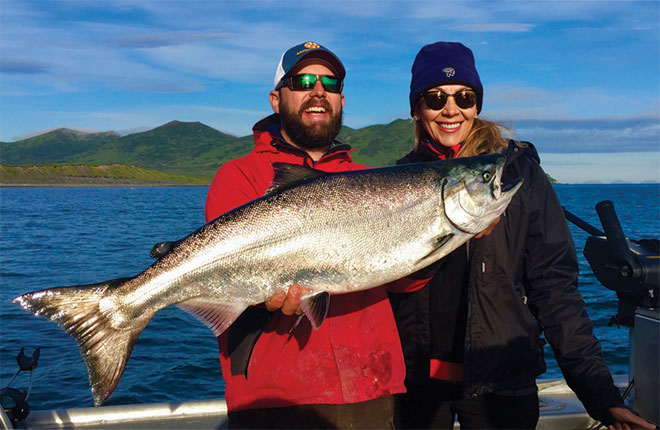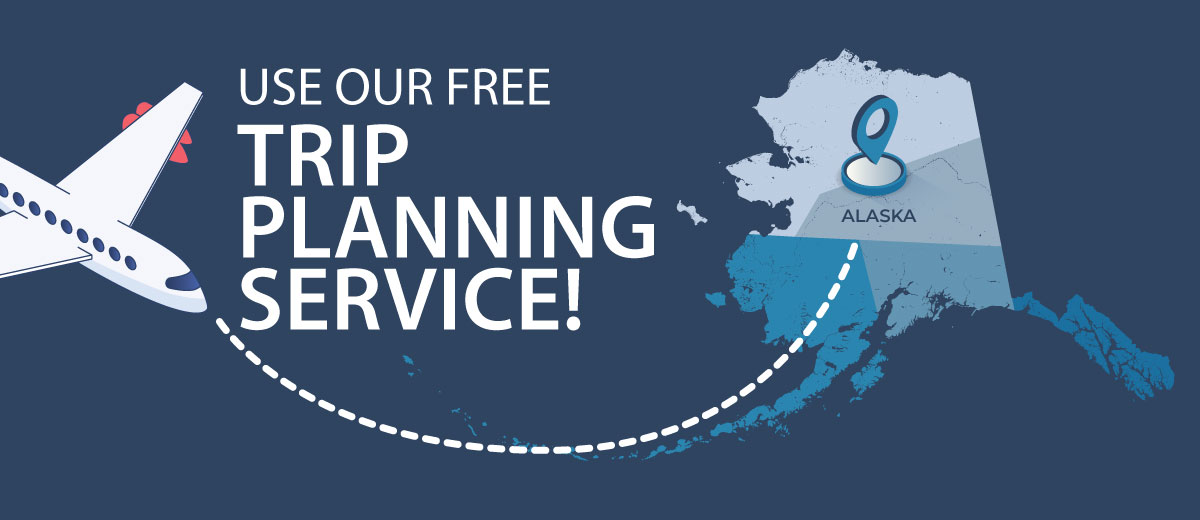Ocean Conditions
Blog by George Krumm
Photo courtesy of Kodiak Legends Lodge

Saltwater kings on Kodiak have seen a good showing in recent years. Kodiak Legends Lodge in Larsen Bay shows off a Chinook catch of theirs. © Kodiak Legends Lodge
All up and down the west coast, most Chinook stocks are “at a period of low abundance.” There are many reasons why. Some of the factors for low abundance outside Alaska waters include habitat modification or destruction, hydropower projects, hatcheries, and harvest. These factors have played a huge role on the west coast, but also on the east coast and in Europe for Atlantic salmon populations.
In Alaska, we have avoided the problems of habitat, hydropower, and hatcheries for the most part (The 5 H’s are described in David R. Montgomery’s book, King of Fish). History, the 5th “H” has begun to rear its head, and may be a growing problem. The “H” we have not been immune to, and which probably plays a big role in Chinook abundance, even in Alaska, is harvest.
To understand the peculiarities of Chinook harvest, we need to consider the peculiarities of the Chinook population. They are by far the least numerous of Pacific salmon. They are also in demand out of proportion to their numbers due to their large size and high fat content, both by commercial fishermen and sport anglers. The population is characterized by numerous age classes—more so than other salmon species. For instance, in a given year the Kenai River will see returning fish that have been in the ocean for 2, 3, 4, 5, or even 6 years. This longer ocean phase is perhaps one of the reasons Chinook populations in Alaska are suffering. More on this in a minute.
If you were to ask an avid angler or even an ADF&G biologist why our State Fish’s numbers are down, it is fairly common to get the broad-brush answer of “ocean conditions.” But what does that mean?
Ocean conditions are made up of many factors. Over the past several years we’ve had an unusually warm northeast Pacific Ocean—a condition referred to as “the Blob.” Unusually high ocean water temperatures cause an increase in warm-water predators. This means juvenile king salmon migrate out into a more hostile ocean than they would on normal-temperature years. What’s more, this warmer ocean supports fewer of the planktonic organisms on which juvenile salmon prefer to feed. So we have more predators than usual, and less food for juvenile salmon.
Man is also a predator of king salmon. Man fishes for salmon not only in the rivers, but also the estuaries, bays, inlets and open ocean. If predators are part of “ocean conditions,” then man, too, falls into that category since we are predators. We harvest Chinook salmon of various age classes in the ocean, sometimes intentionally as in the commercial and sport fisheries targeting kings saltwater. But there is also a high degree of unintentional harvest—bycatch—much of which is simply discarded overboard. Some think the unintended bycatch (or “harvest”) of the Bering Sea trawl fishery targeting pollock is the main reason for the decline of Yukon kings.
So harvest contributes to or is part of “ocean conditions”, though most don’t really think of “ocean conditions” that way.
Our fishing gear, both commercial and sport, has evolved over the years, making us much more effective predators than we were even 30 years ago. Yet despite the increase in effectiveness at catching fish, we have not advanced much in our understanding of excessive harvest. Or, perhaps we just don’t exercise our understanding of it yet. Chinook salmon are not an infinite resource, not even in Alaska where the habitat is still in good shape; where hydropower hasn’t cutoff spawning and inhibited migration of smolts; and hatcheries have not watered down the gene pool of many populations of Chinook. What seems to be the largest immediate problem for Chinook in Alaska is harvest.
Would a corn farmer harvest the crop in early June? Of course not. The crop isn’t mature then, and the yield wouldn’t make financial sense. Yet Chinook salmon are harvested at many age classes while they are still out in the pasture (the ocean), oftentimes years before they mature and begin their spawning migration back towards their natal rivers. What’s more, the ocean fishery is a mixed-stock fishery—salmon from both healthy populations and endangered populations mix out in the ocean, and both are harvested. The fish that are genetically programmed to stay at sea longer (like Kenai mega-kings, fish that spend 4, 5 or 6 years in the ocean) are more likely to be caught before they mature than fish that mature after 2 or 3 years in the ocean. So, we’re actually imposing unnatural selection on the population—it has become more advantageous for fish to mature young and return to spawn as a small king than it is to stay in the ocean and mature as a much larger fish. In my opinion, ocean harvest, both intentional and bycatch, is a huge part of the “ocean conditions” problem facing king salmon, both in Alaska and throughout their range.
What is the solution to this part of the “ocean conditions” problem? We can’t easily control everything affecting Chinook, but a couple ideas seem possible: Stop the large-scale, incidental commercial bycatch of Chinook salmon; and stop indiscriminate fishing for Chinook salmon on the ocean pasture. To do this, we’d need to move all commercial Chinook fishing to more terminal areas near river mouths that can support harvest. We’d need to require the use of truly selective gear for any fishery likely to encounter Chinook, and eliminate the use of gear that isn’t truly selective. By truly selective, I mean gear that is likely to result in a fish that can make it to the spawning grounds and could effectively spawn if it were released. Some examples would be employing the use of fish traps, beach seines, most sport-angler tackle and other truly selective gear.
Note that I said it is possible for us to affect the harvest component of “ocean conditions,” not easy. Some long-held traditions would have to change. Some will view this as a political argument, but I don’t see it that way. If we want vibrant populations of wild king salmon for future generations, I can see no other way to positively impact “ocean conditions” as they relate to king salmon than to take these measures now—as soon as possible—before it’s too late.
George Krumm is the Editor of Fish Alaska and Hunt Alaska magazines. He can be reached at George@FishAlaskaMagazine.com.
This blog originally appeared as the Creel column in the January 2020 issue of Fish Alaska.


